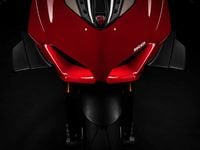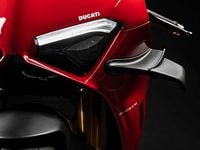Two years after the release of its acclaimed, game-changing V-4 superbike, Ducati is updating the Panigale V4 and V4 S by adopting features that debuted on the V4 R.
Straight away, Ducatisti will notice both models now resemble the homologation special, boasting the same slippery bodywork that punches a larger hole through the air and gives the rider a larger cockpit to hide behind. Both models are visually distinguished from the R by their painted steel tanks and plastic winglets (the R features a brushed aluminum tank and carbon fiber wings).
During the world premiere in Rimini on the Adriatic coast of Italy, Ducati CEO Claudio Domenicali said the aerodynamic package makes a palpable difference on the track: During testing at Jerez—from the last corner to the finish line—the 2020 model gained 2.5 meters on the 2019 model. So there you go.
In CW's superbike shootout, we criticized the Panigale V4 for being tiring to ride over race distance compared to the latest batch of superbikes. Based on similar feedback from customers and other press outlets, Ducati aimed to make the Panigale easier to ride without sacrificing its exhilarating nature. To accomplish its goals, it refined the chassis in a number of ways.
First, it increased the center of gravity by 5mm to make direction changes easier. It also gave the suspension softer springs with more spring preload, in addition to a new shorter rear shock linkage. Ducati claims the changes help increase rider confidence, especially over rough surfaces.
Ducati also massaged the chassis, milling out a section of the cast frame to decrease torsional stiffness by 30 percent and decrease braking stiffness by 15 percent. It's the same chassis change we saw debut on the V4 R last year, and is aimed to improve front end feel and decrease front tire stress, particularly at deep lean angles.
On the engine/electronics side, Ducati developed dedicated racetrack ride-by-wire settings that allow torque delivery to more closely mirror the rider’s throttle input. In first to third gears, torque delivery is also more linear.
There’s also an updated Ducati Traction Control (DTC) Evo 2 system said to improve corner exit control by responding to loss of grip more quickly to reduce the peaks at which it intervenes. In order to ensure the smoothest possible engine response, the system not only varies ignition advance and fuel injection, but also the throttle body valves in conditions when super-fast control isn’t required.
Both models receive updated Ducati Quick Shifter (DQS) Evo 2 tech that shortens upshift times.
It's nice to see Ducati updating its halo model on a two-year cycle,[just like in the good old days when liter-class sportbikes ruled the world. Who else can't wait to swing a leg over this thing?
MSRPs receive a $500 bump with the base model starting at $21,995 and the S at $28,395. There’s no word yet on US availability.
























/cloudfront-us-east-1.images.arcpublishing.com/octane/QCZEPHQAMRHZPLHTDJBIJVWL3M.jpg)
/cloudfront-us-east-1.images.arcpublishing.com/octane/HXOUJXQWA5HBHGRO3EMJIGFMVI.jpg)

/cloudfront-us-east-1.images.arcpublishing.com/octane/3TIWWRV4JBBOLDVGRYECVVTA7Y.jpg)
/cloudfront-us-east-1.images.arcpublishing.com/octane/KIX5O23D5NAIBGFXBN3327DKZU.jpg)
/cloudfront-us-east-1.images.arcpublishing.com/octane/7GJYDUIPXRGMTMQKN6ONYOLBOU.jpg)
/cloudfront-us-east-1.images.arcpublishing.com/octane/MUQLOVLL2ZDGFH25ILABNBXKTI.jpg)
/cloudfront-us-east-1.images.arcpublishing.com/octane/TNOU5DNE2BC57MFPMGN2EIDXAM.jpg)
/cloudfront-us-east-1.images.arcpublishing.com/octane/GTCXACQGJ5HAPDTGWUQKDEH44E.jpg)
/cloudfront-us-east-1.images.arcpublishing.com/octane/S35YGSEMEZB4BLTDJTSZPF4GLA.jpg)
/cloudfront-us-east-1.images.arcpublishing.com/octane/5UOT6HPX2JFMRJAX6EH45AR4MQ.jpg)
/cloudfront-us-east-1.images.arcpublishing.com/octane/OKWOJWAKP5EP3OACCRRWPCIX2Q.jpg)
/cloudfront-us-east-1.images.arcpublishing.com/octane/2WF3SCE3NFBQXLDNJM7KMXA45E.jpg)
/cloudfront-us-east-1.images.arcpublishing.com/octane/G4MG6OUCJNBSHIS2MVVOTPX65E.jpg)
/cloudfront-us-east-1.images.arcpublishing.com/octane/IIGGWFOTOJGB7DB6DGBXCCMTDY.jpg)
/cloudfront-us-east-1.images.arcpublishing.com/octane/QSTCM6AVEZA5JJBUXNIQ3DSOF4.jpg)
/cloudfront-us-east-1.images.arcpublishing.com/octane/U4I7G625B5DMLF2DVIJDFZVV6M.jpg)
/cloudfront-us-east-1.images.arcpublishing.com/octane/B6XD6LS6IVCQPIU6HXDJSM3FHY.jpg)
/cloudfront-us-east-1.images.arcpublishing.com/octane/ICL63FEDDRDTTMINYICCEYGMDA.jpg)
/cloudfront-us-east-1.images.arcpublishing.com/octane/FCGZHQXRBZFLBAPC5SDIQLVF4I.jpg)
/cloudfront-us-east-1.images.arcpublishing.com/octane/WNOB6LDOIFFHJKPSVIWDYUGOPM.jpg)

/cloudfront-us-east-1.images.arcpublishing.com/octane/X33NU3E525ECRHXLNUJN2FTRKI.jpg)
/cloudfront-us-east-1.images.arcpublishing.com/octane/6KKT5NNL2JAVBOXMZYS5ZO76YA.jpg)